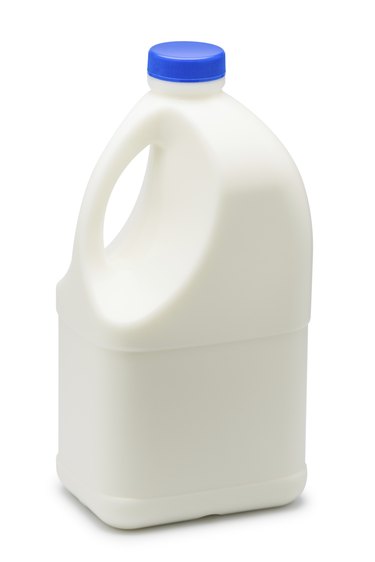
The different components of milk can confuse some people trying to decide which of them cause dietary difficulties or allergies, and the kinds of milk most appropriate for sensitivities. Skim milk, for example, has had the fat removed, which changes the caloric content but does not affect the proteins or sugars in the milk. As such, skim milk still contains lactose, which makes it inappropriate for people with lactose intolerance.
Lactose
Video of the Day
Lactose, also called milk sugar, belongs with the carbohydrate class of macromolecules. As a macromolecule -- large molecule -- lactose requires the lactase enzyme to break it up during digestion. If you do not have this enzyme, or do no have enough of it, you cannot digest lactose. When you ingest milk sugar, you have to digest the lactose into its two simple sugar units, also called disaccharide units, glucose and galactose. Your intestine can then take up glucose and galactose into your bloodstream, explain Drs. Reginald Garrett and Charles Grisham in their book "Biochemistry." Skim milk, like other types of milk, contains a large quantity of lactose.
Video of the Day
Skim Milk
When manufacturers produce skim milk, they remove the fat. Originally, skim milk producers allowed whole milk to sit until the fat floated to the top. Manufacturers would then skim the fat off the top of the milk, leaving a much lower-fat liquid behind. Today, a machine called a centrifuge pulls fat to the top of the milk for removal. Skimming milk does not remove any proteins or sugars; it affects only the fat content.
Lactose Intolerance
Some people have difficulty consuming milk and other dairy products because they cannot produce lactase, the enzyme responsible for digesting lactose. Lactase breaks lactose down into its constituent units for absorption, explains Dr. Lauralee Sherwood in her book "Human Physiology." When undigested lactose passes into the lower gut, bacteria digest it; this results in gas formation, which leads to cramping. With lactose intolerance, you cannot use skim milk as an appropriate alternative to other milks, because you can still react to the lactose.
Skim Milk Alternatives
If you struggle with lactose intolerance and want to consume skim milk or something similar, you have several options. You can take a digestion aid, such as Lactaid. This contains lactase and temporarily allows you to digest the lactose in milk. Alternately, you can use a lactose-free skim milk the manufacturer pretreats with lactase, or low-fat milk alternatives like soy milk. Though lactose-free soy milk does not taste exactly like cow's milk, it works in baked goods just as milk does.